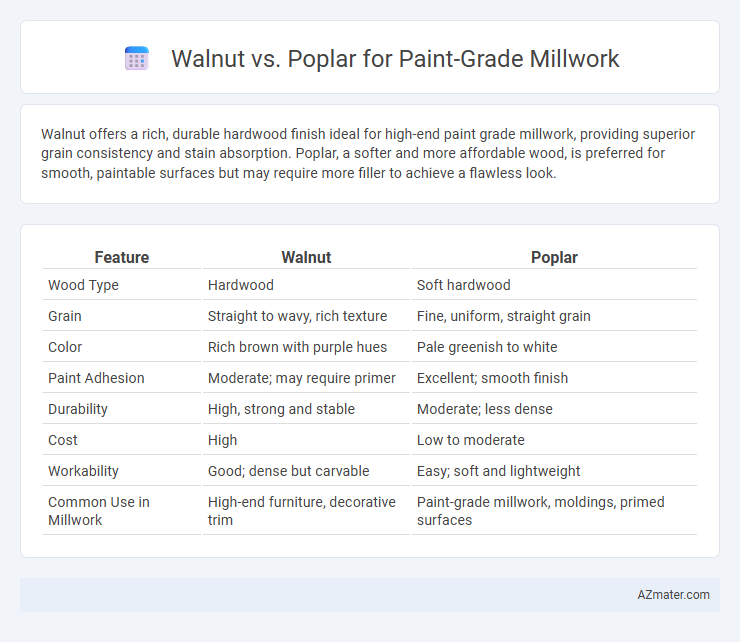Walnut offers a rich, durable hardwood finish ideal for high-end paint grade millwork, providing superior grain consistency and stain absorption. Poplar, a softer and more affordable wood, is preferred for smooth, paintable surfaces but may require more filler to achieve a flawless look.
Table of Comparison
| Feature | Walnut | Poplar |
|---|---|---|
| Wood Type | Hardwood | Soft hardwood |
| Grain | Straight to wavy, rich texture | Fine, uniform, straight grain |
| Color | Rich brown with purple hues | Pale greenish to white |
| Paint Adhesion | Moderate; may require primer | Excellent; smooth finish |
| Durability | High, strong and stable | Moderate; less dense |
| Cost | High | Low to moderate |
| Workability | Good; dense but carvable | Easy; soft and lightweight |
| Common Use in Millwork | High-end furniture, decorative trim | Paint-grade millwork, moldings, primed surfaces |
Introduction to Paint Grade Millwork
Paint grade millwork requires wood species with smooth surfaces that accept primer and paint uniformly, making walnut and poplar common choices. Walnut offers rich color and tight grain but often requires extensive sanding and priming due to its natural oils, whereas poplar features a softer texture and consistent grain, providing excellent paint adhesion at a lower cost. Selecting between walnut and poplar depends on factors like project budget, desired finish quality, and ease of paint application in millwork production.
Key Differences Between Walnut and Poplar
Walnut exhibits a rich, dark brown color with a fine, straight grain, making it ideal for high-end paint grade millwork that demands a premium finish and natural beauty. Poplar, in contrast, is lighter with a cream to yellow-green hue and a more uniform texture, offering a smooth surface that accepts paint exceptionally well and is more cost-effective for large projects. Durability and hardness also differ; walnut is harder and more resistant to dents, while poplar's softness allows for easier machining but may require more careful handling during installation and finishing.
Wood Grain Characteristics: Walnut vs Poplar
Walnut exhibits a rich, deep brown color with a pronounced, straight grain interspersed with occasional waves and curls, creating a luxurious and visually appealing pattern ideal for paint-grade millwork. Poplar features a more subtle, straight, and fine grain with uniform texture and pale yellowish to greenish hues, which allows for smooth, even paint application without visible grain interference. The distinct grain characteristics of walnut offer a natural elegance, while poplar's consistent grain enhances the durability and finish quality of painted surfaces.
Paint Adhesion and Finish Quality
Poplar wood exhibits superior paint adhesion compared to walnut, making it a preferred choice for paint grade millwork due to its smooth, consistent grain and softer texture, which allows for better primer and paint absorption. Walnut, with its dense and oily characteristics, often requires additional surface preparation to achieve a comparable finish quality, potentially increasing labor and material costs. Paint grade millwork prioritizes ease of finishing and durability of the paint layer, positioning poplar as the more practical option in environments demanding high-quality painted surfaces.
Cost Comparison and Budget Considerations
Walnut is significantly more expensive than poplar, often costing two to three times more per board foot, making it less feasible for budget-conscious paint grade millwork projects. Poplar's affordability and consistent grain make it an ideal choice for economical millwork that requires a smooth painted finish. Choosing poplar over walnut can maximize budget efficiency without compromising the quality of painted millwork products.
Durability and Longevity Under Paint
Walnut offers moderate durability for paint grade millwork but tends to have tighter grain patterns that may show through paint over time, requiring thorough surface preparation. Poplar is highly favored for paint grade millwork due to its smooth texture, uniform grain, and superior paint adhesion, ensuring a long-lasting finish with minimal maintenance. Both species are stable woods, but Poplar generally provides better longevity under paint due to fewer natural oils and less grain visibility.
Workability and Ease of Machining
Walnut offers excellent workability due to its medium density and uniform texture, allowing smooth cuts and minimal tear-out, making it ideal for detailed paint-grade millwork. Poplar is highly favored for ease of machining, exhibiting minimal blunting of tools and consistent grain patterns, which reduces setup time and achieves clean, precise edges in painted finishes. Both species respond well to sanding and priming, but poplar's affordability and forgiving nature in machining often make it the preferred choice for large-scale paint-grade millwork projects.
Environmental Impact and Sustainability
Walnut and poplar differ significantly in environmental impact and sustainability for paint grade millwork; walnut is a slower-growing hardwood often sourced from older forests, which raises concerns about deforestation and habitat loss. Poplar, a fast-growing, renewable soft hardwood, is more sustainable due to its shorter harvest cycles and widespread availability in managed plantations. Using poplar reduces carbon footprint and promotes responsible forestry practices, making it a greener choice for environmentally conscious millwork projects.
Best Applications for Walnut and Poplar in Millwork
Walnut is ideal for high-end paint grade millwork due to its fine grain and smooth surface, enhancing detailed moldings and cabinetry that require a luxurious finish. Poplar is favored for its consistent texture and affordability, making it perfect for primed interior trim, baseboards, and window casings where a smooth paintable surface is essential. Both woods provide excellent adhesion for paint, but Walnut offers superior durability and aesthetic appeal for premium projects.
Final Recommendations: Choosing the Right Wood
Walnut offers a rich, dark grain and durability ideal for premium paint grade millwork, while poplar provides a smooth, light surface that accepts paint evenly at a lower cost. For projects emphasizing high-end aesthetics and longevity, walnut is the preferred choice despite its higher price point. Poplar is better suited for budget-conscious applications where a flawless painted finish and ease of workability are priorities.

Infographic: Walnut vs Poplar for Paint Grade Millwork
 azmater.com
azmater.com